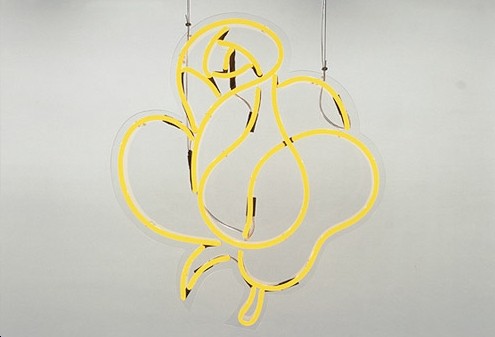Cerith Wyn Evans
26 May - 25 Aug 2007
CERITH WYN EVANS
"Socle du Monde"
In his exhibition of new works at Galerie Daniel Buchholz, Cerith Wyn Evans incorporates a wall text by the artist Julie Ault on the writing of history – the thinking of history – described as a set of ‘loose continuums of production’. Ault sees the proper articulation of history engendering conflicting or differing meanings, facts and positions. Like art, she suggests, the past can be summoned by ‘interpretative and creative’ acts, a kind of critical remembrance, producing wildly discursive, heterogeneous relations to space and time through corresponding ‘events, activities and associations of ideas’.
And like the wall text, the works on display function both as objects and as signposts or maps to other systems of thought and production. It is in the simultaneous, differential register of their perception, however, where the ‘work’ of the work occurs: it is activated through an act of self-dispersal in a play with other signs, objects and positions. The work becomes an invocation of references and articulations from past, present and future.
In the Elisenstrasse gallery ‘Socle du Monde’ recalls Piero Manzoni’s canonical 1961 sculpture, an inverted bronze plinth that seizes the world itself as a work of art. Cerith Wyn Evans replaces Manzoni’s ‘weight’ or ‘base of the world’ with a common set of scales, upturned, with a sachet of vitamins attached, inverting the absent body and disrupting figure-ground relations. In the window of the gallery is a yellow neon representation of a rose displayed as a shop sign, superabundant with references to art and literature: Rrose Selavy (Duchamp), Ordeal by Roses (Mishima), ‘A Rose is a Rose is a Rose’ (G. Stein). It is sourced originally as the logo from the Japanese department store Takashimaya. In the Neven-DuMont-Strasse gallery, along with the Ault text, is a suite of ink drawings with concealed radio transmitters broadcasting live. These calligraphic gestural abstractions variously allude to John Cage’s and Brion Gysin’s explorations into Zen Buddhism.
In as much as these discrete works of art could be described as auto-biographical ‘appropriations’, they could also be described as decoys, paradoxically false and counterfeit aggregations of the artist’s ‘self’. As such they function more like modes of transport for the transmission of genealogies and narratives, creating in turn a kind of ‘social imaginary’: a repertoire of individual and collective ‘scripts’ from cultural memory, a poetics of possibilities.
"Socle du Monde"
In his exhibition of new works at Galerie Daniel Buchholz, Cerith Wyn Evans incorporates a wall text by the artist Julie Ault on the writing of history – the thinking of history – described as a set of ‘loose continuums of production’. Ault sees the proper articulation of history engendering conflicting or differing meanings, facts and positions. Like art, she suggests, the past can be summoned by ‘interpretative and creative’ acts, a kind of critical remembrance, producing wildly discursive, heterogeneous relations to space and time through corresponding ‘events, activities and associations of ideas’.
And like the wall text, the works on display function both as objects and as signposts or maps to other systems of thought and production. It is in the simultaneous, differential register of their perception, however, where the ‘work’ of the work occurs: it is activated through an act of self-dispersal in a play with other signs, objects and positions. The work becomes an invocation of references and articulations from past, present and future.
In the Elisenstrasse gallery ‘Socle du Monde’ recalls Piero Manzoni’s canonical 1961 sculpture, an inverted bronze plinth that seizes the world itself as a work of art. Cerith Wyn Evans replaces Manzoni’s ‘weight’ or ‘base of the world’ with a common set of scales, upturned, with a sachet of vitamins attached, inverting the absent body and disrupting figure-ground relations. In the window of the gallery is a yellow neon representation of a rose displayed as a shop sign, superabundant with references to art and literature: Rrose Selavy (Duchamp), Ordeal by Roses (Mishima), ‘A Rose is a Rose is a Rose’ (G. Stein). It is sourced originally as the logo from the Japanese department store Takashimaya. In the Neven-DuMont-Strasse gallery, along with the Ault text, is a suite of ink drawings with concealed radio transmitters broadcasting live. These calligraphic gestural abstractions variously allude to John Cage’s and Brion Gysin’s explorations into Zen Buddhism.
In as much as these discrete works of art could be described as auto-biographical ‘appropriations’, they could also be described as decoys, paradoxically false and counterfeit aggregations of the artist’s ‘self’. As such they function more like modes of transport for the transmission of genealogies and narratives, creating in turn a kind of ‘social imaginary’: a repertoire of individual and collective ‘scripts’ from cultural memory, a poetics of possibilities.

